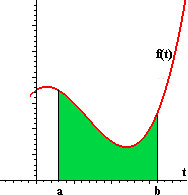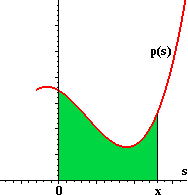|
|
|
|
|
|
The following statement is called the First Fundamental Theorem of Calculus (FTC1): If f is any continuous function whose domain includes 0, then

We established the truth of this statement in Part 1.
In Part 2 we showed that, if f is any differentiable function whose domain includes 0, then

This statement is not quite the Second Fundamental Theorem, but we can easily derive the theorem from it.


where h is any antiderivative of f '. There is nothing special in this formula about the names f ' and h. For example, we could state the same fact this way:

where p is a continuous function with 0 in its domain, and P is any antiderivative of p. This is the Second Fundamental Theorem of Calculus (FTC2) -- although it is usually stated in different notation.
Next we see that there is nothing special about 0 as the fixed "base" for definite integration to the variable upper limit in either FTC1 or FTC2.

[Hint: Recall the argument that led to this formula, based on estimating a difference quotient for F(x). By the time we calculated a difference of values of F, there was no longer any mention of the left end point of integration. Thus, that left end point could have been any a and the answer would have been the same.]

where F is any antiderivative of f.
[Hint: A strategy is suggested by the following figures:

|

|
Steps 2 and 3 give the conventional statements of FTC1 and FTC2. Naming of the fundamental theorems is not universally agreed upon. In some textbooks they are numbered in the other order. Sometimes they are stated as a single Fundamental Theorem with parts 1 and 2, again with the order determined by the author.
|
|
|
| modules at math.duke.edu | Copyright CCP and the author(s), 1999 |